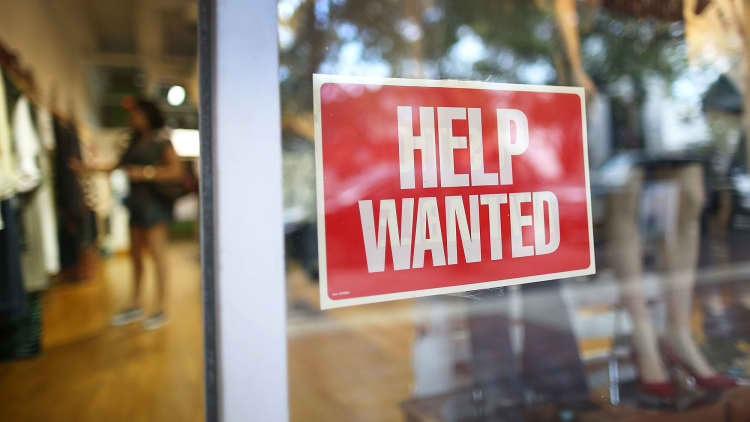
Economists are forecasting that a healthy 205,000 jobs were created in March, but the numbers may not add up as expected.
Key in Friday's March employment report will be average hourly wages, expected to rise 0.3 percent and the labor participation rate, which has been edging up since October. Unemployment is expected to hold steady at 4.9 percent.
But what's been making the rounds in the bond market is the fact that in seven of the past eight years, the government's first print of March payroll data has significantly missed the mark, falling below the consensus of Wall Street economists by a wide margin. Talk of this trend came as Treasury yields Thursday hit their lowest level in more than a month. The U.S. 2-year note was yielding 0.729 percent, and the 10-year was at 1.77 percent.
"While the consensus is 205,000, there are whispers the number might come in lower given that in seven of the last eight years, March payrolls have come in on average 45,000 lower than the consensus median," said Dana Saporta, director, economic research at Credit Suisse. Saporta expects to see 190,000 jobs for March. But she also discounts the March negativity.
"It could be a random event. If you look at a greater period of time, March doesn't really stand out," she said. In the 15 March reports since 2000, March has been just the sixth-worst month for missing consensus on the first print of payroll data, but since 2008, it has been first, she noted.
Read More 5 risks that could surprise markets in the second quarter
Deutsche Bank chief U.S. economist Joseph LaVorgna said he expects 175,000 nonfarm payrolls, both because of the historic softness in recent March data and the sluggish economy. He looked back at five of the past six years and found a higher average miss of 53,000 in March.
"How much employment growth can you have in a quarter when growth is up half a point? It implies productivity is just really horrible for the quarter, which also implies pretty weak profit margins," said LaVorgna. "One-hundred seventy-five thousand is still a very good number. I think the risk is we're going to get a very weak number between now and the end of June. History would tell us we're due for one. Given where we are in the cycle and given where productivity growth is."
Read MoreAnbang walking away from $14B Starwood deal
The March employment report is expected at 8:30 a.m. EDT Friday, and there are also a couple of other important data points Friday. ISM manufacturing, showing contraction for several months, is expected to recover and climb above 50, when it is reported at 10 a.m. EDT Friday. Expected at 50.5, a reading above 50 means expansion in the manufacturing economy which seems to be on the mend. There is also construction spending at 10 a.m., Markit PMI at 9:45 a.m. and car sales are reported throughout the morning.
Ahead of the jobs report, the S&P 500 drifted lower Thursday, losing 0.2 percent to 2059, in its first negative trading day in four. The S&P was up 0.8 percent for the first quarter and was up 6.6 percent in March, its best month since October.
Read More5 reasons you might want 'to sell in May'
"A consensus number would cause the (bond) market to sell off at least three basis points, and then we'd drift higher back to unchanged on the day, and it wouldn't change anybody's monetary policy expectations," said Ian Lyngen, senior Treasury strategist at CRT Capital. But if the number is much lower than expected, he says to expect a big rally with bond prices rising and yields falling.
John Briggs, head of strategy Americas RBS, said the number shouldn't impact the markets much unless it's negative, at which point it would cause buying in bonds. That could also cause buying in stocks, as traders would see the Fed on hold. The markets are currently not expecting a rate hike at the Fed's next two meetings, and one is barely priced in to the end of the year.
Fed Chair Janet Yellen may have squeezed some of the volatility out of markets with her comments this week that the Fed will move cautiously and there are risks to its forecasts on the economy and inflation. She said the labor market has made satisfactory progress but highlighted concerns about inflation lagging and the risks from foreign markets.
"Yellen's telling you it doesn't matter, and if it's weak people will say, 'Here is the foreign spillover into domestic markets,' " said Briggs.
Read MoreLow-paying jobs distorting the bigger picture
Bank of America Merrill Lynch deputy head of U.S. economics Michelle Meyer said she is expecting 190,000 jobs but she is most interested in the labor participation rate, averaging about 66 percent before the financial crisis and lagging since.
It has begun to pick up in recent months to 62.9 percent and that could be an important trend, she said.
"It's hugely important because it indicates people are starting to come back in to the labor force in a much greater way. You might not get as much wage pressure if there's that type of slack in the labor market," she said.
Read More US consumers whipping out the credit cards again
Meyer said she has not seen any evidence of a systematic problem with March employment data. But she does ultimately expect the pace of hiring to slow, but not because of current weakness in the first quarter. In February, 242,000 jobs were higher, more than expected.
"We are tracking pretty weak for Q1. It does seem that GDP is coming out to be pretty sluggish in Q1 ... it doesn't mean the labor market has to slow in tandem. We have had in the last few quarters this gap between what the jobs are showing and the GDP numbers," she said.


